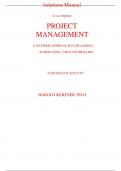Solutions Manual to accompany PROJECT MANAGEMENT A SYSTEMS APPROACH TO PLANNING, SCHEDULIN G, AND CONTROLLI NG THIRTEENTH ED ITION HARO LD KERZNER, PH.D. Contents Chapter 1 Problems ............................................................................ 1
Chapter 2 Problems ............................................................................ 3
Chapter 3 Problems ............................................................................ 4
Chapter 4 Problems ............................................................................ 5
Chapter 5 Problems ............................................................................ 7
Chapter 6 Problems ............................................................................ 9
Chapter 7 Problems .......................................................................... 10
Chapter 8 Problems .......................................................................... 11
Chapter 9 Problems .......................................................................... 12
Chapter 10 Problems ........................................................................ 13
Chapter 11 Problems ........................................................................ 14
Chapter 12 Problems ........................................................................ 16
Chapter 13 Problems ........................................................................ 18
Chapter 14 Problems ........................................................................ 20
Chapter 15 Problems ........................................................................ 22
Chapter 16 Problems ........................................................................ 23
Chapter 17 Problems ........................................................................ 24
Chapter 18 Problems ........................................................................ 25
Chapter 19 Problems ........................................................................ 27
Chapter 20 Problems ........................................................................ 28 CHAPTER 1 1–1 There is no correct answer to this problem, just preferred choices. 1.a, b, c, d, f, g, i, k, m, n, p
2. b, d, e, h, i, j, k, m, n, o, p
3.a, c, d, f, g, i, j, m, n, p
4. b, d, e, h, i, j, k, m, n, o, p
5. b, d, h, i, l, m, n, p
Moral: Even in the best companies, differing views of project management are possible. Differing views also occur whether the company is project-driven or non-project-driven. Also, the views can change as the company gets reasonably more mature in project management. 1–2 Project management was originally designed for industries that have complex (as opposed to simple) tasks and that operate in an ever-changing, dynamic (as opposed to sta tic) environment. These include aerosp ace, defense, construction, computers, high technology, electrical instrumenta tion, and the like. Comp anies that have highly repetitive tasks, such as low- technology manufacturing companies, do not need formal project management but can use informal project management for activities such as capital equipment projects. Furthermore, project management works best in situa tions where activities require the involvement of more than one functional group. Today, project management exists in almost all companies, and some firms believe that they are managing their business by projects. 1–3 In general, the most import ant attributes of a project manager are communicative skills and interpersonal skills. Individuals cannot be trained to be a project manager simply by taking courses or attending seminars. Project managers can only be developed by on-the-job training, especially under the guidance of an experienced project manager. Some companies prefer to train project managers by first ro tating them through the various line organizations (say two weeks to two months each) and then assigning them as an assist ant project manager. The question, of course, is how much they can learn in such a short period of time. Promoting from within is best because the first few project managers must know the tot al organiza tion. If functional employees see promotions from within, then they feel that there are several career paths in the company. However, the new project managers must be able to divorce themsel ves from the functional organiza tion. It is often best to hire from the outside so tha t you will have a project manager who does not have any functional ties and does not owe any favors. 1–4 Functional managers would prefer to manage projects which s tay entirely Project Management Instructor’s Manual 1 Chapter 1




